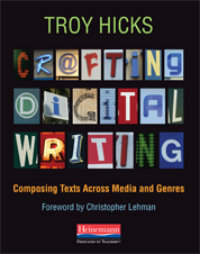Crafting Digital Writing
Crafting Digital Writing: Composing Texts Across Media and Genres
By Troy Hicks
(Heinemann, 2013 – Learn more)

Throughout my 22 years of teaching, I have seen many changes in education. The biggest change, however, has been the use of technology in the classroom. No longer can a teacher sit back, with arms crossed, and refuse to have anything to do with the creepy box that pings and makes noise in the corner.
Today, teachers have to be open-minded about using technology with their students; today’s teens grew up with a computer in their hands. The problem is this: With so many technology options out there, it is difficult to know where to start. The book Crafting Digital Writing: Composing Texts Across Media and Genres by Troy Hicks can be a safety net for those who are a little overwhelmed by trying to find the right technology to use with their students.
What’s inside the book

It is not a book that provides lesson plans you can use the very next day, but that doesn’t matter; this book gives you many ideas of where to start when it comes to digital writing.
Crafting Digital Writing is divided into nine chapters:
1. Overview of the Book
2. Author’s Craft, Genre Study, and Digital Writing
3. Crafting Web Texts
4. Crafting Presentations
5. Crafting Audio Texts
6. Crafting Video Texts
7. Crafting Social Media
8. Modeling and Mentoring the Digital Writing Process
There are many exciting ideas in this book. Hicks has included QR codes that you can scan to view student examples and mentor texts. He also offers his Wikispace website address where you’ll find material that complements each chapter – and ideas to use with your own students. This is not a book that you can sit and read for very long without your computer in front of you; he provides many different websites, so that you feel “inclined” – no, you feel “excited” – to search out each one. Hicks also includes charts with overviews for each website.
Following MAPS; Dodging PowerPoints
In Hicks’ other book, The Digital Writing Workshop (2009), he introduced an idea called MAPS: mode, media, audience, purpose, and situation. I am glad that he has chosen to include this idea in this book also. For each type of digital writing, he refers back to MAPs and how it helps “the writer determine when, how, and why he or she chooses to use a particular element of author’s craft” (p21). This is important because many teachers tend to introduce or use technology for “technology’s sake.” We need to introduce students to different digital tools that are out there, but we also need to teach them about appropriate use.
One of my favorite chapters is regarding “crafting presentations.” As teachers, we tend to fall back on the old standby of PowerPoint presentations for our lessons. Even worse is having to watch 160 student PowerPoint presentations about a certain topic. Yes, those presentations give me nightmares. Fortunately, Hicks provides new alternatives. He gives ideas on everything from using multimedia websites (most I had never heard of), to infographics, to sketching, to screencasting… All of them would engage students much more in the classroom.
Engagement comes first
Engaging students is one of my main goals as a teacher. In fact, whenever I plan a unit, my first question is always about how it will engage the students and how they will share out their learning. I never want to be their only reader. This is why I found Hicks’ chapter on crafting social media so interesting.
These days, students use social media on a daily basis. But are teachers helping them to become intentional about their writing in these spaces? Hicks creates a nice metaphor when he states, “Social media is the telephone for this generation of teens (and, increasingly, adults)” (p140). In other words, teens are more likely to post something on social media than they are to pick up the phone and call their friend. Since this is the case, we need to teach students how to communicate in safe and effective ways as they use these tools. It is an interesting concept to view Tweets as mentor texts. Hicks discusses how to use everything from microblogging to group text messaging and using social bookmarks.
I strongly recommend this book to any teacher who uses writing in their classroom (and hopefully, that is everyone). If you have been wanting to engage your digital-age students more, but you haven’t felt comfortable with engaging them with technology, Hicks presents ideas for digital writing in an easy-to-read format. I felt as if Hicks was my professional-technology-guru, sitting by my side. And that isn’t easy to come by.
Judi Holst is an 8th grade Language Arts teacher in Colorado. She is a Curriculum Instructional Leader, a Discovery Education STAR Ambassador, and the Gifted & Talented Lead in her district. She has been in the teaching field for 22 years and has taught grades Kindergarten through 8th grade. She has presented at the AMLE Conference, the International Reading Association Conference, and the Colorado Council International Reading Association Conference. You can read her teaching blog at http://tbdteacher.tumblr.com/.


































